Realization of a Coherent and Efficient One-Dimensional Atom. N. Tomm, N. O. Antoniadis, M. Janovitch, M. Brunelli, R. Schott, S. R. Valentin, A. D. Wieck, A. Ludwig, P. P. Potts, A. Javadi and R. J. Warburton in Phys. Rev. Lett. 133:083602 (2024). What the paper says!?
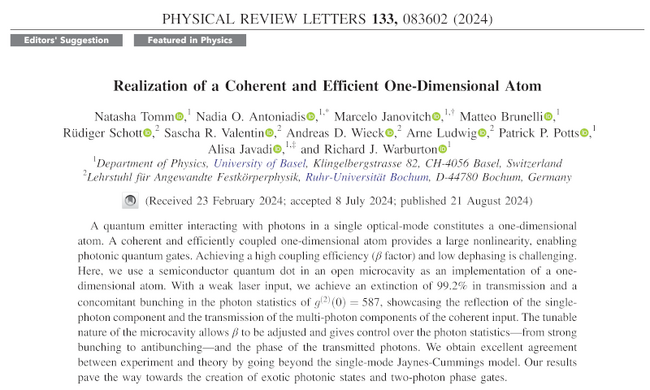
This studies the coherent driving of a QD in a microcavity (Jaynes-Cummings physics, although because they have two QDs and two cavity modes, the Authors describe this as "beyond Jaynes-Cummings", which is a necessity due to their actual system, when they would have preferred an actual JC one). More perplexing is that they call their system a "one-dimensional atom", defined as «a quantum emitter coupled to a single optical mode [4]» with Ref. [4] featuring a 1D waveguide.
They characterize the emission from the transmission, reflection and $g^{(2)}$. They report a record value of $g^{(2)}(0)=587$:
The most striking results are the strong extinction and the high bunching of the transmitted state, both metrics for the nonlinearity, both much higher than in previous realizations
They also introduce the "Rice-Carmichael state" terminology:
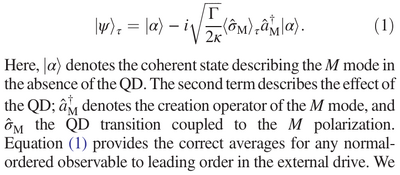
This is a superposition of a coherent state $\ket{\alpha}$ with a photon-added coherent state. They compute $g^{(2)}$ from this using only coherent fractions, which seems hazardous, given the role of fluorescence in the two-photon correlations:[1]
The $\beta$ factor is used to tune the statistics, itself tuned by changing the position of the QD in the cavity (which is not convenient for a device). They use a polarization beam-splitter, with Port 2 detecting so-called M polarization
One of the paper's main claims is flawed, namely, that it acts as a single-photon filter:
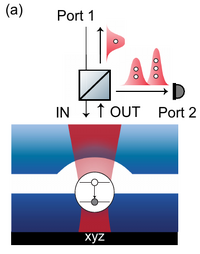
The effect dies with increasing pumping and is thus reminiscent from the Heitler regime.
$g^{(2)}(0)$=587, showcasing the reflection of the single-photon component and the transmission of the multi-photon components of the coherent input
The bunching is also reminiscent of Heitler divergence[2] (but is here attributed to a nonlinearity):

On the explanation of the superbunching: This bit says nothing:
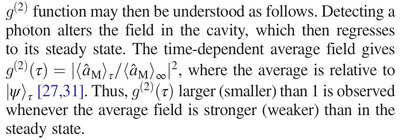
This bit is better, but still blundering the leading order.
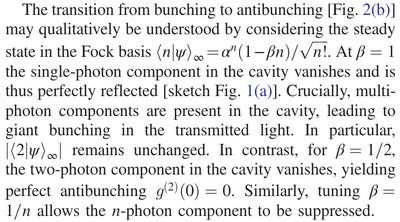
They also find a dip in $g^{(2)}$$(\tau)$ that they attribute to "photon bound-state", which is not an explanation but a reason for "bound states", if anything.
Physics
The paper is also featured in Physics, where the above mistakes are even more glaring:

Richard Warburton of the University of Basel, Switzerland, and his colleagues have demonstrated a device whose input is a weak laser and whose output is a stream of single photons from one port and groups of multiple photons from another port
The mechanism, describing a sort of multiphoton transistor, is also wrong:
The incoming weak laser light can be thought of as a combination of single photons, photon pairs, photon triplets, and so on. Like an atom, the quantum dot absorbs a single photon whose energy matches the separation of two of its energy levels and then emits a photon with the same energy. But if two or more photons are present, the interaction changes, which, in this setup, changes the polarization of the output state. By directing this output through a polarization-sensitive beam splitter, the device selects the port through which the output light is emitted based on the number of photons that interact with the quantum dot.
And on the superbunching observed:
the so-called second-order correlation function, a measure of the “bunching” of photons—essentially, the absence of single-photon states
References
- ↑ Origin of Antibunching in Resonance Fluorescence. L. Hanschke, L. Schweickert, J. C. López Carreño, E. Schöll, K. D. Zeuner, T. Lettner, E. Zubizarreta Casalengua, M. Reindl, S. Filipe Covre da Silva, R. Trotta, J. J. Finley, A. Rastelli, E. del Valle, F. P. Laussy, V. Zwiller, K. Müller and K. D. Jöns in Phys. Rev. Lett. 125:170402 (2020).

- ↑ Conventional and Unconventional Photon statistics. E. Zubizarreta Casalengua, J. C. López Carreño, F. P. Laussy and E. del Valle in Laser Photon. Rev. 14:1900279 (2020).
